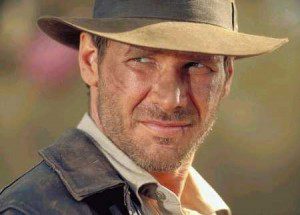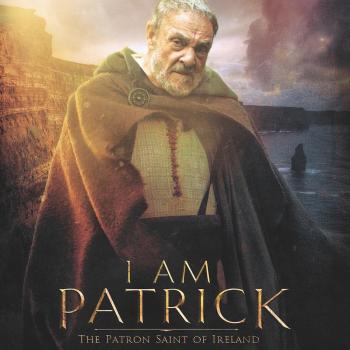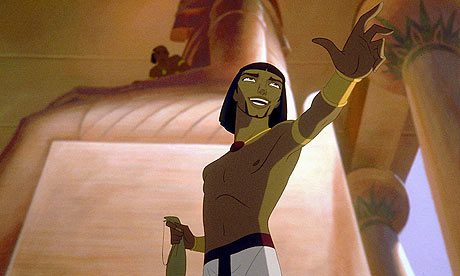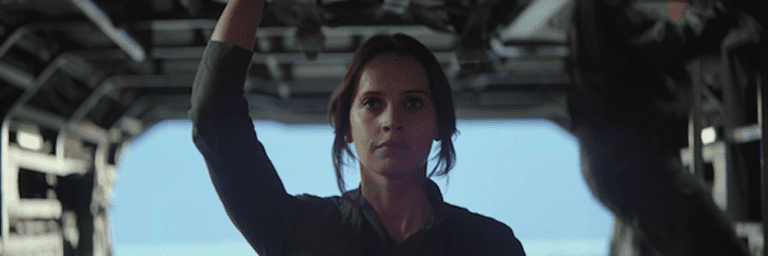 “Didn’t any of you guys ever go to Sunday school?” So said Indiana Jones to a couple of bemused military intelligence agents in Raiders of the Lost Ark, easily the top-grossing film of 1981 and one of the greatest action movies ever made. And thus producer George Lucas and director Steven Spielberg seemed to make explicit what had only been implicit in the handful of films that they had made over the previous few years — films that had captured an entire generation’s spiritual imagination.
“Didn’t any of you guys ever go to Sunday school?” So said Indiana Jones to a couple of bemused military intelligence agents in Raiders of the Lost Ark, easily the top-grossing film of 1981 and one of the greatest action movies ever made. And thus producer George Lucas and director Steven Spielberg seemed to make explicit what had only been implicit in the handful of films that they had made over the previous few years — films that had captured an entire generation’s spiritual imagination.
Lucas, of course, had helped to revive interest in the power of myth with his space-opera throwback, Star Wars (1977), and its sequel, The Empire Strikes Back (1980); the latter was particularly heavy on the spiritual development of its hero, Luke Skywalker. Some Christians, keen to capitalize on the franchise’s popularity, even went so far as to draw extensive analogies between the first movie and the biblical narrative; the fact that Obi-Wan Kenobi was betrayed by his disciple, and died, and continued beyond death as a counsellor to Luke was, of course, key to their interpretations.1 Spielberg, for his part, had directed Close Encounters of the Third Kind (1977, re-edited and re-released in 1980), a film about aliens that spoke very strongly to the longing for enlightenment from above; in both images and dialogue, the film even made indirect references to the story of Moses and his encounter with God on Mount Sinai.2
Now here they were, collaborating on their first movie together, a tongue-in-cheek ode to the Saturday matinee serials of their youth — and it was all about the Ark of the Covenant, the gold-plated chest within which the Israelites had stored the tablets of the Law, and above which the spirit of God himself was said to reside. There was no need for allegory here; this movie really was bringing a piece of the Bible to life. Even better for an 11-year-old Bible geek like me (I would begin my first subscription to Biblical Archaeology Review just a couple years later), the hero of the film was an archaeologist who spoke knowledgeably about obscure biblical characters like the Pharaoh Shishaq. No one really knows what became of the Ark in the end — outside the Ethiopian Orthodox Church, at any rate, which claims to have the Ark — but the film floated a theory that was, at least, plausible: that the first foreign power to attack Jerusalem after Solomon’s death had taken the Ark away, along with all of the Temple’s other gold-plated treasures.3
Everything after that — the Egyptian city buried by an ancient sandstorm, the Staff of Ra containing the jewel that points the way to the building that houses the Ark, and all the various fights and chases that ensue between Indy and the Nazis — was just plain, old-fashioned Hollywood nonsense, of course. And the sequels which followed turned increasingly silly and cartoonish — none more so than Indiana Jones and the Kingdom of the Crystal Skull, which brought the character back to the big screen this past summer for the first time in almost 20 years. But the original movie was animated by a biblical idea — even to the point where the Ark itself steals the show from the film’s ostensible hero — and if you look at the franchise as a whole, it is possible to isolate some striking developments in their approach to faith, family, and the seemingly divine.
Perhaps the most intriguing thing about this series is that, if you watch the films in sequential order — the second film, Indiana Jones and the Temple of Doom (1984), is actually a prequel that takes place one year before Raiders — you can chart a spiritual journey of sorts from paganism to Judaism to Christianity and, now, alas, to some sort of post-religious, pseudo-scientific, New Age sensibility. In a strangely microcosmic and presumably unintentional form, the spiritual journey of Indiana Jones happens to match that of the civilization which produced him.4
Temple of Doom captures Indy at both his most and least heroic. Set in 1935, the film begins in a Shanghai nightclub, where Indy is about to close a deal with a local ganglord, exchanging the ashes of the Manchu emperor Nurhaci for a valuable diamond. When the deal goes sour, Indy grabs the nightclub’s singer, Willie Scott (Kate Capshaw), and sticks a fork in her side, threatening to harm her if her boss doesn’t give in to his demands — not exactly the sort of behavior one expects from a good guy. But then a fight breaks out, mayhem ensues, one thing leads to another, and before they know it, Indy and Willie and a kid named Short Round (Ke Huy Quan) find themselves stuck on a pilotless plane somewhere over India.
Indy and the others jump from the plane in an inflatable life raft and, improbably, survive, their raft eventually settling near a village that has been wasting away ever since its children were abducted by a local cult of Thuggees, followers of the Hindu god Kali. A village elder tells Indy that the cult also took the village’s Sankara Stone, an object without which the village cannot prosper — and he adds that the Hindu god Shiva brought Indy there to retrieve the stone and save the village.
Indy doesn’t buy the supernatural stuff, and he tells Short Round not to worry because what the elder told them was nothing more than “a ghost story.” But he is interested in the Sankara Stone — which, if genuine, would mean “fortune and glory” for him when he took it to America. So he goes to nearby Pankot Palace, with Willie and Short Round at his side, and there he witnesses horrifying displays of human sacrifice and child slavery at the hand of the Thuggees and their leader, Mola Ram (Amrish Puri). By the end of the film, Indy has had a change of heart, liberated the children, defeated the bad guys, and returned the Stone to its village, which now prospers. A final exchange between Indy and the village elder establishes that Indy now “understands” the Stone’s power.
Raiders takes place one year later. A couple of federal agents tell Indy that the Nazis are on the verge of discovering the Ark of the Covenant in an ancient, ruined Egyptian city, and they want him to claim it for the United States before the Germans get it. Despite his experiences the previous year — which, of course, had not been written or filmed yet — Indy is a skeptic once again, scoffing when his colleague Marcus Brody (Denholm Elliott) cautions him not to take the job too lightly. “I don’t believe in magic, a lot of superstitious hocus-pocus,” says Indy. “I’m going after a find of incredible historical significance, you’re talking about the bogeyman.”
By the end of the film, however, Indy has become a believer all over again. With the help of a former girlfriend, Marion Ravenwood (Karen Allen), Indy does indeed find the Ark, but all three of them are captured by the Nazis, who bind Indy and Marion to a pole and allow them to watch from a distance as René Belloq (Paul Freeman), a mercenary French archaeologist, opens the Ark and peers inside — which, as anyone who has read their Bible could have told them, is a definite no-no.5 Spirits emerge, bodies melt, and in a matter of minutes everyone is dead except for the two lovers — both of whom are alive, it is suggested, because Indy remembered at the last minute that they should shut their eyes and avoid making eye contact with the divine.6 The film ends with the American government locking the Ark away in a warehouse, as Indy grumbles that those “bureaucratic fools . . . don’t know what they’ve got there.”
Indy tussles with the Nazis again in Indiana Jones and the Last Crusade (1989), but this time they are fighting for possession of the Holy Grail. If the Ark of the Covenant is situated right at the heart of the Old Testament, providing the crucial link between Sinai and Zion, the Holy Grail exists somewhere on the cusp between the New Testament and post-biblical legend—but ultimately it points to Christ, who used the cup at the original Last Supper and who, according to the legends, shed some of his blood into that cup from the cross. Once again, Indy starts off as a skeptic, trading “bedtime stories” with Walter Donovan (Julian Glover), a wealthy American businessman who hires Indy to help him look for the Grail before revealing himself to be a villain collaborating with the Nazis; but by the end of the film, Indy has met a legendary, centuries-old knight, drunk from the Cup of Christ himself, and shared it with his once-estranged father, Henry Jones, Sr. (Sean Connery). Once again, Indy has gone from being a doubter to being a believer.
The pattern repeats itself in Kingdom of the Crystal Skull, but in this episode the question of doubt and belief is tied to a decidedly more secular subject. The new film takes place in 1957, nearly two decades after Indy’s last big-screen adventure,7 and the villains are Soviets: atheists with an interest in psychic research, rather than the occult-obsessed Thuggees and Nazis of the previous films. Led by the Ukrainian Colonel Irina Spalko (Cate Blanchett), they are particularly interested in finding the remains of extraterrestrials whose ships have crashed in various parts of the world, including the legendary UFO wreckage supposedly found in Roswell, New Mexico in 1947. The film begins with the Soviets taking Indy as a prisoner to Area 51 and compelling him to find the crate that contains the alien; not coincidentally, this turns out to be the same warehouse where the Ark of the Covenant was stored many years before, though this fact is revealed only to the audience, and not to Indy.
Thanks in part to a scheduled nuclear test, Indy escapes the Russians, but the fact that he helped them in any capacity puts him under a cloud of suspicion. Indy is ready to leave America and pursue a job at the University of Leipzig in East Germany — not the best way, perhaps, to assure the authorities that he isn’t a Red — but his plans are interrupted when a young greaser named Mutt Williams (Shia LaBeouf) enters his life and asks for his help in finding an old friend, Harold Oxley (John Hurt). Oxley, we are told, was obsessed with crystal skulls, artifacts that supposedly go back to ancient Latin America, and which some say have magical powers. Before long, it turns out that Oxley has been captured by Spalko, too, and that the particular skull he has discovered is not only the work of extra-terrestrials, as some have speculated, but is part of an actual extraterrestrial skeleton.
Indy, as always, mocks the idea when it is first presented to him, but Spalko forces him to make a psychic connection with the skull, and from that point on, all of the various characters are determined to bring the skull back to the legendary temple, hidden somewhere in the South American jungle, from which it was stolen a few hundred years before. Indy does it to help Oxley, and also, he says, because the skull told him to. Spalko does it because she hopes to find the power that will enable her and her comrades to rule the world by controlling the minds of their enemies. But what they find is a throne room filled with 13 alien skeletons, one of which is missing its head — and when they put the crystal skull back in its place, the aliens all come to life and demonstrate that they have a hive mind of their own. Spalko asks them to give her all the “knowledge” in the world, and they oblige, overwhelming her brain with so much data that her body basically evaporates. For their part, Indy and his friends manage to escape before the temple collapses and the aliens depart in a flying saucer.
In some ways, the new film marks a significant departure from the others, inasmuch as it ignores the myths, legends, and relics of ancient religions, instead taking as its starting point a phenomenon that cannot be traced back with any certainty to any point earlier than the 19th century, which is when crystal skulls first began to show up on the antiquities market. What’s more, the film fuses this phenomenon to a decidedly cheesy sci-fi premise, typical of the decade in which the film is set but lacking any remotely resonant connection to the beliefs and practices of any significant number of people in the real world. In at least one way, however, the new film does bring the franchise full circle, since Raiders itself began with Indy going to South America in search of an idol based on a fertility symbol that some scholars consider to be a 19th-century forgery with no basis in actual cultic practices.8
Some elements have remained relatively constant over the course of the series, such as Indy’s frustrated relationship with the government. The British army may ride to the rescue at the end of Temple of Doom, but from the sheriff who confiscates the Cross of Coronado in Last Crusade to the federal agents who spread the notion that Indy is a Communist spy in Crystal Skull, the American authorities always seem to come off as unreliable or untrustworthy, at best.
Other themes have developed in interesting ways over the course of the franchise, though, such as its portrayal of sexuality and the family. Indy was originally conceived as a James Bond-like character — hence the casting of Connery, the original Bond, as his father — and each of the first three films presented him with a different leading lady. But each film also introduced other characters, seen or unseen, who either eclipsed or extended these relationships, as if to suggest that Indy wanted or needed something more than the isolated couplings that Bond usually settles for. Indy’s boldly promiscuous flirtations in Temple of Doom and Last Crusade pale next to his fraternal love for Short Round and his filial love for his father, respectively. In Raiders, the romance runs deeper, partly because Marion is a figure from Indy’s past whose father, now dead, was a mentor of sorts to Indy until they had a falling out over Indy’s relationship with his daughter. The reunion of Indy and Marion thus raises the possibility that old wounds can still be healed, though it isn’t until the second half of Crystal Skull — when Indy meets Marion again for the first time in 20 years, discovers that Mutt is their son, and marries her — that the reconciliation becomes permanent.
But if the series has gotten increasingly pro-family, it has also moved further and further away from anything resembling a religious or explicitly theological sensibility. At the climax of Temple of Doom, Indy seems to align himself with the Hindu gods when he recites a spell in Sanskrit and tells Mola Ram, repeatedly, “You betrayed Shiva.” In Raiders, Indy is surprisingly less inclined to invest the Ark with religious significance. In the early scenes, where he is still skeptical of the Ark’s power, he does throw away a line to the effect that the Ark is said to have exuded the “power of God or something.” But in the final scenes, after he has witnessed the power for himself, he does not connect it to anything explicitly theological. Even Brody, who had earlier expressed concern about going after such a supernatural object, insists that “the Ark is a source of unspeakable power and it has to be researched,” as though the power of God were something that could be subjected to scientific analysis. In Last Crusade, the Holy Grail takes a back seat to the father-son relationship just like everything else, and the Grail’s significance is reduced to a pop-spirituality cliché worthy of Dan Brown. “The search for the Cup of Christ is the search for the divine in all of us,” Brody declares.
Crystal Skull pushes things even further, by substituting extraterrestrials or “inter-dimensional beings” for the gods and supernatural relics of the previous films. But there are other, subtler clues that science has supplanted religion, as well. The nuclear bomb that nearly kills Indy at the beginning of the film also destroys a test village populated by mannequins, and it causes their faces to melt, not unlike the faces that melted when the Nazis opened the Ark in Raiders. And the mushroom cloud that looms over Indy seems a more frightful spectacle, more out of control, than the pillar of fire that poured out of the Ark. Later, the film draws our attention to the fact that Robert Oppenheimer, one of the bomb’s designers, quoted a Hindu scripture while claiming that he had become a “destroyer of worlds”; the destructive power of the gods is now in the hands of men.
Oxley, for his part, often cites a line from John Milton’s Comus about a “Golden Key / That [opens] the Palace of Eternity.” In its original context, the line is spoken by a Greco-Roman spirit and refers to the bliss that awaits the virtuous after death, when they are greeted and rewarded by “the enthron’d gods on Sainted seats.” But here, it refers to the elaborate mechanisms that take heroes and villains alike into the room with the enthroned aliens, and the “reward” they offer is something that people would be better off avoiding.
Oxley also draws Indy’s attention to the Nazca Lines, a series of Peruvian geoglyphs that, in his words, “only the gods can see,” because the patterns they form are said to be visible only from the air; but modern technology has given Indy and his friends the ability to soar above these lines and see them from the gods’ point of view. And when all is said and done, Indy marvels that the ancient people who worshiped these aliens did so because the aliens gave them “knowledge” — that is, the knowledge to develop basic technologies such as agriculture and irrigation, neither of which seems particularly supernatural to anyone today. If these “gods” meant anything deeper to the people who worshiped them, the film never suggests what it might have been.
For fans like myself, it is impossible not to feel disappointment at the note on which the franchise has now concluded. A number of critics have suggested that there is no real difference between the aliens of Crystal Skull and the religious artifacts of the earlier films; they’re all just mystical MacGuffins, and equally silly, or so these critics say. But no matter how pulpy the earlier films were, they at least turned our attention to matters of the spirit and stoked a sense of awe. Crystal Skull has nothing that compares to this; indeed, the characters even perform autopsies on the “gods” of the past.9 It’s safe to say this is one Saturday matinee that won’t be getting much play in Sunday school.
Peter T. Chattaway lives in British Columbia and writes about movies.
1. A prime example of this is Frank Allnutt’s The Force of Star Wars (Bible Voice, 1977).
2. Note the mountain where the humans and aliens make contact, and note the scene where Richard Dreyfuss and Teri Garr discuss whether to let the kids watch The Ten Commandments (1956).
3. 1 Kings 14:25-28; 2 Chronicles 12:1-11.
4. I owe this point to Dan’l Danehy Oakes, who charted the progression of the first three movies on Coinherence, an e-mail discussion list devoted to Charles Williams, back in 1996.
5. Witness the fate of the 70 men who peered into the Ark in Beth Shemesh (1 Samuel 6:19). Depending on the circumstances, one could also die by touching the Ark (2 Samuel 6:6-11; 1 Chronicles 13:9-14) or even just by being in its presence (Leviticus 16:2). There is also a biblical precedent for the form of divine judgment whereby the bodies of certain characters rot while they are still standing (Zechariah 14:12).
6. Cf. Exodus 33:20, where God tells Moses that “no one may see me and live.”
7. Harrison Ford had also played the character in the bookends of an episode of The Young Indiana Jones Chronicles (1993) set in 1950. While it is not clear to what degree we should regard that series as canonical, Indy does tell Mutt in Crystal Skull about an incident from that series that happened when he was about Mutt’s age.
8. Jane MacLaren Walsh, “Legend of the Crystal Skulls,” Archaeology (May/June 2008). www.archaeology.org/0805/etc/indy.html
9. For all their enlightenment, these aliens do seem to have a tendency to crash their ships. And just how was the crystal skull stolen from the body of its alien in the first place, anyway?
— A version of this article was first published in Books & Culture.












